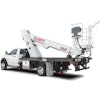
Randy Truckenbrodt has been involved with the aerial lift industry since it was in its infancy, getting his start as a distributor for Genie Industries in the mid-1970s, even before the manufacturer offered powered access equipment. For nearly 25 years, he was a top sales agent for Genie. Today, Truckenbrodt leads U.S. Markets, a wholesale re-rental supplier of AWPs and telehandlers, as well as independent, regional equipment rental companies in Illinois, Indiana and Florida.
In this exclusive interview with Rental, Truckebrodt discusses the current business environment and strategies for small rental owners to survive and thrive.
Rental: Given current predictions for 2016 construction trends, is now a good time for rental companies to be adding to their fleet?
Truckenbrodt: Yes. ARA’s latest forecast is for stable growth in the rental industry, and the mood among rental owners at the February 2016 show in Atlanta was generally positive. We’re adding some new and some used equipment to our fleets, especially 85- to 180-foot boom lifts. While the drop in oil prices has depressed some new construction activity, the available used equipment represents a good opportunity for rental companies looking to pick up quality, low-hour and reconditioned machines for their fleets.
The bigger negative impact on fleet acquisition and expansion, however, is current lending practices. After the most recent recession, access to capital has tightened up. Even if your company didn’t previously default on a loan, just by being part of the rental industry, you are immediately considered part of the leper colony. Likewise, getting financing through the OEMs can be difficult when you don’t necessarily know who the lending institution is behind the curtain.
Rental: Speaking of The Rental Show, each year manufacturers introduce new models and technology to the market. How can a small rental company evaluate those trends and stay competitive? And what caught your eye at the show?
Truckenbrodt: We have a high sales component that is part of our revenue, which means that being a pioneer in the market is a key strategy for USM. We were the first rental company to receive the Genie SX-180, a 180-foot self-propelled boom lift, for example. Today we own more than 20 of these super booms. When a machine like this is introduced at the highest end of a product line, new markets and applications get exposed. According to OSHA standards (126.1431(a) http://us-markets.com/osha-personnel-platform/), if a dedicated tool exists for lifting personnel to those heights then that becomes the preferred method over lifting people with a crane and basket. That’s opened new opportunities in stadium and bridge construction, for example.
At the 2016 show, we saw several atrium lifts that interest us for our re-rental fleet. Re-rental of specialty equipment is a lower risk option for rental companies wanting to test their local market with something that may have a high acquisition cost or limited application.
More important to a small company is having a quality sales force. It comes down to the tenacity of the sales department to understand your local customer needs. You have to be responsive to the customer. In this regard, wholesale rental offers an avenue for a smaller company to tap into cutting edge equipment. USM has depots dispersed around the country and if a specialty machine is available locally, that can be an affordable option for rentals lasting at least a month.
Rental: What are other benefits of re-rental and what role should that play in fleet planning?
Truckenbrodt: USM’s re-rental fleet is a mix of specialty equipment and middle of the road aerials and telehandlers available in high volume. We are in the business of helping other companies grow their rental business and expand into new markets. Re-rental gives small companies access to longer term rents and access to bigger equipment they wouldn’t normally invest in. They can also project a bigger image in the marketplace.
For a small company, that might mean renting an 80-foot boom lift for six months to allow them time to evaluate a purchase in that class. Or maybe a dealer has one 80-foot boom lift available for rental, but doesn’t want to tie it up on a long rental. By renting a second machine from us, they are able to generate rental income for their regular daily, weekly monthly rental customers, while they work to build their fleet.
As another example, we had a customer that had a specific project that required 20 one-person vertical lifts. It’s not a specialty product, but it was a category that they weren’t currently marketing. They were willing to commit to the machines for one year. By renting them, they could decide to put their capital expenditures elsewhere. At the end of the year, they could return them or sell them. So we acquired the vertical lifts for their use. In the end, they decided not to keep them. We were able to either find homes for them or sold them on the used market.
Back to the lending and banking issue, we also help companies with startups. Without access to capital, it’s possible to launch a rental company from the ground up with re-rental.
Rental: Don’t you worry that you will fund a competitor who could dislodge you from a market?
Truckenbrodt: No. The market is huge. It’s a viable, growing, and changing market. You can’t force feed equipment into a market when there isn’t demand for it. But if you are responsive to the customer, small rental companies can have significant success. They are more nimble than the big companies, and they understand things like utilization, maintenance costs, etc., more organically than larger companies.
Because we’ve been left with this residual caution on the part of the banks, I think there is great opportunity for alternative financing options. The amount of documentation and the methods used to compile the documentation takes way too long to get loan approval. We have experienced it taking five to six months. Even if they can get the credit, smaller companies don’t have the bandwidth to wait. Re-rental allows smaller companies to be more reactive to the opportunity. Demand for equipment is pretty immediate. You just don’t get six months advance notice to get the credit you need to buy the fleet you need to support the job.
One other note of caution. When it comes time for credit renewals, banks can be slippery by changing the terms, often at the last minute. Small companies might assume they are getting the same deal, but the devil is in the details.
Because it has become so difficult to do business with banks, they may end up killing their own golden goose. Re-rental enhances the situation; it helps companies grow their businesses faster than they ever could waiting on a response from the banks.
Rental: Are there other ways for small rental companies to outsource services in order to improve their responsiveness?
Truckenbrodt: It’s not necessary for a rental company to be full-service if they can partner with other companies that may specialize in aspects of their business. Re-rental is just one aspect of what USM offers. Whether the rental company is big or small, we can provide maintenance or restore their equipment. We can sell them used equipment, or help them divest their own older units. We can help them rebalance their fleet with both new and used equipment.
Finding skilled technicians remains a problem. The Association of Equipment Distributors recently released a study that estimates that U.S. heavy equipment distribution industry loses at least $2.4 billion each year as a result of inability to find and retain skilled technicians. Many companies don’t have idle labor. Finding time and staff to perform a 25 to 50 hour repair can be difficult. Or they might not have the facilities, such as access to a paint shop, for a major refurb. In some metro areas where there is unionized labor, they truly cannot afford the labor to do some of this type of work. So sending it away somewhere else becomes more reasonable than trying to fix equipment in house. Outsourcing those services allows rental companies to remain focused on their core business.
Many rental companies are not oriented to selling used equipment. Like maintenance, the task becomes a distraction. And while OEMs will take used equipment on trade, they often won’t deal in small quantities, so it’s more difficult for a smaller rental company to re-balance their fleet without taking on the risk and exorbitant fees associated with the auctions. Instead, a company like ours is much more adaptable to the small dealer’s needs. One last example: A few years ago, we had 600 scissor lifts that we were ready to sell. We packaged them in units of five and sold them off to small rental houses to give them an opportunity to get into the aerial lift market. The reason we created this package is that you’re not really in a market with just one to two units. But with five, you can really explore the rental opportunity. Later they might expand to other aerial equipment or increase their fleet size. It worked pretty well.




















